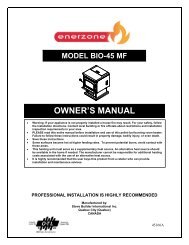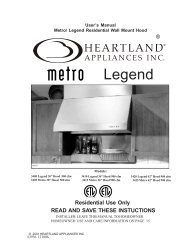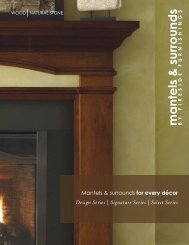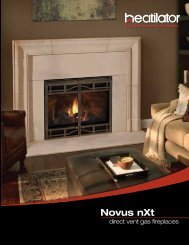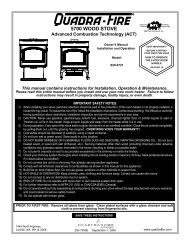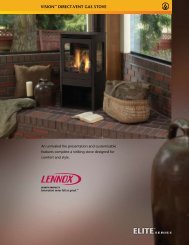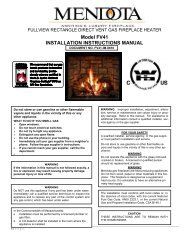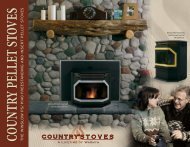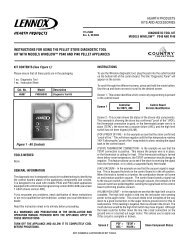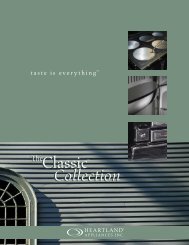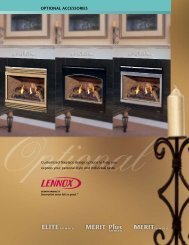EPA Certified Wood-Burning Fireplace Insert - Inglenook Energy ...
EPA Certified Wood-Burning Fireplace Insert - Inglenook Energy ...
EPA Certified Wood-Burning Fireplace Insert - Inglenook Energy ...
You also want an ePaper? Increase the reach of your titles
YUMPU automatically turns print PDFs into web optimized ePapers that Google loves.
INSTALLATION AND OPERATION MANUAL<strong>EPA</strong> <strong>Certified</strong><strong>Wood</strong>-<strong>Burning</strong><strong>Fireplace</strong> <strong>Insert</strong>Retain These InstructionsFor Future ReferenceP/N 775,211M, Rev. A, 04/2007Striker C160Striker CA160<strong>Wood</strong> <strong>Fireplace</strong> <strong>Insert</strong>sStriker Models C/A160A French manual is available upon request. Order P/N 775,211CF.Ce manuel d’installation est disponible en francais, simplement en faire la demande. Numéro de lapièce 775,211CF.These appliances must be properly installed and operated in order to prevent thepossibility of a house fire. Please read this entire installation and operationmanual before installing and using your wood stove. Failure to followthese instructions could result in property damage, bodily injury oreven death. Contact your local building or fire officials to obtaina permit and information on any installation requirementsand inspection requirements in your area.WARNINGS• Hot! Do not touch! The glass and surfaces of this appliance willbe hot during operation and will retain heat for a while aftershutting off the appliance. Severe burns may result.• Carefully supervise children in the same room as appliance.
ContentsTesting Information..........................................................................3General Safety Precautions.................................................................3Drafting......................................................................................4Negative Pressure Warning ............................................................4Creosote.....................................................................................4Ash Disposal.................................................................................5Fuel..........................................................................................5Break-In Period..............................................................................5Paint Curing.................................................................................5Brick Installation............................................................................6Required Clearances.........................................................................7Hearth Protection...........................................................................7Chimney Requirements.......................................................................8Installation Procedure - Masonry Chimney.................................................8Installation Procedure - Factory-Built Zero Clearance <strong>Fireplace</strong>s.......................9<strong>Insert</strong> Pre-Installation Preparation........................................................9Chimney Liner Installation................................................................. 10Installing the <strong>Insert</strong>....................................................................... 10Post Installation Checks.................................................................. 10Operating Hints............................................................................ 11Starting and Maintaining a Fire........................................................... 12Clean Glass................................................................................ 13Operating Techniques and Hints........................................................... 13Getting the Most Out of Your Stove..................................................... 13Maximizing Your Stove’s Overall Efficiency.............................................. 14Achieving Clean, Long Burns.............................................................. 14Maintenance................................................................................ 15Troubleshooting........................................................................... 16Do’s and Don’ts........................................................................... 17
DraftingYour wood stove is dependent upon a properly functioningchimney for optimum performance. It is a high efficiencyappliance that loses much less heat up the chimney thanolder appliances and fireplaces. For this reason it is importantto match the stove to the chimney. The chimney has twofunctions: 1) It draws combustion air into the appliance(without air, no fuel will burn) and 2) It exhausts combustionby-products. Your new Country Collection stove iswhat is known as a “natural draft” appliance. The appliancedepends solely on the natural draft of the chimney systemto draw combustion air into the unit. Draft is the force thatmoves air from the appliance up into the chimney. Theamount of draft in your chimney depends on the length ofthe chimney, local geography, nearby obstructions, and otherfactors. Too much draft may cause excessive temperaturesin the appliance. Slow or inadequate draft equals poorcombustion and possible smoking problems. The twomain culprits of poor chimney draft are: 1) A chimney toolarge for your appliance and 2) A chimney with not enoughheight to produce adequate draft for your particular stovemodel. Your Lennox Hearth Products dealer will be ableto advise you on matching a proper system for your newstove. Inadequate draft will cause the appliance to leaksmoke into the room through the stove and the chimneyconnector joints. An uncontrollable burn or a glowing redstove or chimney part indicates excessive draft. Also seeTroubleshooting on page 16.Negative Pressure WarningThis appliance is not designed to be operated in a negativepressure. Very airtight homes with large kitchen exhaustfans, or homes with furnace cold air returns located inclose proximity to the wood stove or fireplace insert maycreate negative pressure in the same room as the heatingappliance. This can create dangerous back drafting of thestove and chimney joints, drawing combustion by-productsinto the home. Be sure your home has adequate makeupair to eliminate negative pressures caused by the abovementionedsources. Outside air connected to the applianceprobably will not resolve such a problem as the stove orfireplace insert is not the source of negative pressure.Lennox Hearth Products accepts no liability for damagesresulting from negative pressures described above.CreosoteCreosote---Formation and Need for Removal---When woodis burned slowly, it produces tar and other organic vapors,which combine with expelled moisture to form creosote. Thecreosote vapors condense in the relatively cool chimney flueof a slow-burning fire. As a result, creosote residue accumulateson the flue lining. When ignited, this creosote makesan extremely hot fire. The chimney and chimney connectorshould be inspected at least once every two months duringthe heating season to determine if a creosote build-up hasoccurred. If creosote has accumulated, it should be removedto reduce the risk of a chimney fire.NOTE: DIAGRAMS & ILLUSTRATIONS ARE NOT TO SCALE.
Brick InstallationStriker C/A160 Brick InstallationCAUTION: Wear gloves during brick installation incase of sharp edges behind the stove.Note: Installation of baffle bricks and ceramic blanket ismuch easier when you can still access the flue outlet, as inbefore installing the insert. Be sure the insulating blanketis placed flat on the bricks so as not to block the flue andthat it does not hang out over the front of the baffle. Usea ruler or a piece of kindling to reach back over the blanketto be sure it is flat on top of the baffle bricks all the wayback.1. Install bricks #1-18 in the numbered sequence shownin Figure 1.2. Install bricks #19 & 20 into the rear stainless steelbaffle support, See Figures 2 & 3.3. Next install baffle bricks #21-24 by sliding the backof each brick over the center tube and support untilthe front of the brick clears the front tube and support.Then lift the front of the brick above the frontsupport and tube and slide it forward as far as it cango (very important), it will hit the front of the stainlesssupport when it is fully forward. The rear of thebricks sits on top of bricks #19-20 (Figures 2 & 3).4. Carefully slip the ceramic blanket up over the front ofthe front stainless support and bricks #21-24. Graspthe front of the blanket and slide it back until the frontof the blanket is flush to the front of the bricks #21-24 (Figure 3). Shake the blanket gently from side toside to get it to lie flat. Be sure the ceramic blanketis directly on top of the baffle bricks and that it doesnot hang out past the front of the baffle as shown inFigure 2, also see note above.WARNING: IF THE BRICKS AR NOT INSTALLED EXACTLYAS SHOWN THEY COULD FALL OUT OF PLACE DURINGREFUELING OR BURNING OF THE STOVE CAUSING SERI-OUS INJURY.3D2F1F11FFirebrick Diagram7F15 G17 D 18 B8A12A9F13F10F16 EFigure 1Front ViewSee the following for brick sizes*Fits against the back of the firebox.Note: These bricks may be slightly smaller to adjust for steel and firebricktolerances beyond our control. Be sure to measure and markbricks with their numbers when removing.Top View of Baffle Brick19 C20 H17 D 18 B21 F 22 A 23 F 24 F7 8 9 101 F A F F 42FFF5Figure 3 2FD611 12 13 14 DF A F FSide Cut-A-Way View of Firebox15 G16 E14F4FCeramic Wool Insulation Blanket5F6DStriker C/A160 Brick Sizes(see Figures on this page)A = 4-1/4 x 9” E = 1-1/2 x 8-7/8”B = 2-1/4 x 8-7/8” F = Full Brick”C = 3-1/2 x 9” G = 1-1/2 x 9H = 3-1/2 x 8-7/8”D = 2-1/4 x 9”Insulating Blanket Size is 1/2” x 11” x 20” and fits ontop of the baffle brick.Back Wall BrickStainless SteelBaffle Support21 F19 CFigure 3NOTE: DIAGRAMS & ILLUSTRATIONS ARE NOT TO SCALE.
Required ClearancesWARNING: BE ABSOLUTELY SURE THE DISTANCE BE-TWEEN THE HEATER AND THE SURFACE OF ANY COM-BUSTIBLE CONSTRUCTION IS NOT LESS THAN SHOWNON THIS PAGE.Model *A *B *C *D E(1)C/A160C/A160withmanteland/or sideshieldsModel F (1) G H J(2) MC/A160 18”450mmC/A160 withmantel and/orside shieldsUSA-24”CAN-660mm16”406mm18”450mmUSA -15”CAN-450mm10”254mm12-1/2”318mm12-1/2”318mm20”508mm20”508mm19-1/4”489mm19-1/4”489mm12”305mm8”200mm4-3/8”111mm4-3/8”111mm43”1092mm4-3/8”111mm* Reduced clearances may be available for A, B, C, and Ddimensions by using an optional mantel and/or side shields.Consult with your Lennox Hearth Products dealer for thedimensions of the shields. Clearances can also be reducedfor A, B, C and D dimensions per NFPA 211 - latest edition,Standard for Chimneys, <strong>Fireplace</strong>s, Vents, and Solid Fuel-<strong>Burning</strong> Appliances (in Canada CSA B365 - latest edition). Seesection on “Reduction of Appliance Clearance with SpecifiedForms of Protection.”** Side view of optional mantel deflector shown.USA-4-1/2”CAN-200mmUSA-4-1/2”CAN-200mmSIDE WALLSide Facing MaterialTop Facing / TrimCDE (USA)Figure 4Maximum Mantel Depth = 9” (229 mm)COMBUSTIBLE MANTELBA<strong>Insert</strong>Hearth ProtectionM 6-1/2”165mmFMantel**TrimJE (Canada)GH(1)Hearth extension reductions: 2” (51mm) reduction for 2”(51mm) raised hearth. (USA) 16” minimum hearth extensionon all stoves as measured from the door opening of theunit. (Canada) 18”(450mm) minimum hearth extension onall stoves as measured from the door opening of the unit.Minimum distance of floor protection to the side = 8” (200mm).This is measured from the sides of the door opening in theUSA and from the sides of the insert in Canada.(2) J = Maximum lintel depth without flue offset or smokedeflector.Hearth ProtectionFigure 5NotesHearth Protection• Facing material that projects more than 3/4” (19mm) fromthe wall is considered a mantel or side wall.• MINIMUM FIREPLACE OPENING 19-1/2” (495mm) High x25-1/2” (648mm) WideThe hearth and/or floor protection must be a thermally ratednon-combustible hearth/floor protector meeting or exceedinga thermal rating of k=.84 or equivalent with a listed thicknessof 3/8" (9.5mm) minimum in USA (3/4" - 19mm minimum inCanada). The covering must extend 18” (450mm) in frontof the heater and 8” (200mm) to either side (measured fromdoor opening in the USA and measured from the side of theunit in Canada).NOTE: DIAGRAMS & ILLUSTRATIONS ARE NOT TO SCALE.
Chimney RequirementsThe Striker C/A160 inserts are approved for use in masonryfireplaces built to UBC Chapter 37 or equivalent with a minimum22” (559mm) opening at the front of the fireplace.These heaters are designed to be installed into an existingmasonry fireplace (built to UBC 37 or ULC S628 standards)or factory-built, solid-fuel and wood-burning fireplaces (listedto UL 127 or ULC S610) only.Do not remove brick or mortar from masonry fireplace toaccommodate insert. Do not remove brick or mortar frommasonry fireplace to accommodate insert. Approved with orwithout positive flue connection. Approved with minimum6” (152mm) diameter stainless steel listed reline system.Ask your dealer for recommended chimney size. CountryCollection inserts are tested to UL 1482 / ULC S628-93 andlisted by OMNI-Test Laboratories, Inc.; Beaverton, OR.Remove and clean behind unit frequently, as creosote buildup may occur rapidly.Installation Procedures - Masonry ChimneyNote: Although not required, a full-length stainless steel lineris recommended for optimum safety and performance. Seeyour Lennox Hearth Products dealer for details.Note: When installing your stove with a positive flue connection,be sure to leave the insulation off the surround panels(flanges) and leave a 1/4” (6mm) airspace between thesurround panels and the facing of your fireplace.1. READ ENTIRE INSTALLATION INSTRUCTIONS.2. Check all REQUIRED CLEARANCES as specified in theprevious section (page 7) of this installation instructionbooklet.Consult your dealer for the correct attachment piece.Compare lintel depth to the distance from the flue collaropening to the fireplace to determine if this caution pertainsto your installation. If there is sufficient clearance,a flue offset may also be used. Consult your dealer.5. Open or remove the existing fireplace damper. Make surethe damper cannot fall closed.6. Install the two 1/2” x 3” (13mm x 76mm) leveling bolts-heads up- a few turns in the leveling nuts on each sideof the outer chamber of the insert at the lower rear corners.7. Position the insert in the center of the fireplace openingand push it back until the surround brackets are approximately2” (51mm) away from the fireplace front.8. Install the side surround panels and push the insert upsnug against the fireplace face. Then with the locationselected remove the surround panels and level the stovewith the leveling bolts using a 3/4” (19mm) socket, extensions(to reach the bolt head), and a ratchet.9. Glue the insulation around the outer edge of both the topand side surround panels.10. Install the surround panels loosely, align and tighten.Check for a tight fit against the fireplace.11.Install the brick and baffle as per instructions on page6.POSITIVE FLUE CONNECTION: See your authorized LennoxHearth Products dealer for necessary accessories andinstallation instructions.Positive flue connectors required for installation in Canadaare available from your Lennox Hearth Products dealer.Please the part number indicated below.71161 - 6" Positive Flue Connector Ring Kit3. Wear gloves during installation in case of sharp edges onthe stove and it’s parts4. Determine the depth of the fireplace lintel. The lintel isthe masonry area over the fireplace opening, and is supportedby a noncombustible plate, usually of steel. Thedepth may vary from a single brick width (4”/102mm)to that of several brick. If any portion of the flue collaropening on top of the insert (as shown in the diagrambelow) will project under the lintel area, a deflector platemust be mechanically attached to the fireplace insert todivert heat and gases away from the lintel.LintelFlue OutletNot to ScaleBrick Face<strong>Insert</strong>SurroundSmokeDeflectorMechanicallyAttached to<strong>Insert</strong>Figure 6NOTE: DIAGRAMS & ILLUSTRATIONS ARE NOT TO SCALE.
Installation Procedure - Factory-Built ZeroClearance <strong>Fireplace</strong>s<strong>Fireplace</strong> and Chimney RequirementsThe Striker C/A160 insert must only be installed in a zeroclearance factory-built fireplace using 6” (152mm) stainlesssteel pipe extending from the insert’s flue into the chimneyof the fireplace. For optimum safety and performance werecommend a full length stainless steel liner directly connectedto the insert’s flue outlet.The Striker C/A160 insert must only be installed in a zeroclearance factory-built firplace that is structurally sound.Fireboxes or chimneys that have flaws, burnouts, or warpingmust be replaced or repaired prior to installation. Check withyour fireplace manufacturer if any problems exist.All convection vents and louvers must be left unmodifiedand unobstructed.The Striker C/A160 insert can only be installed in the followingbrands of factory-built zero clearance fireplaces:SUPERIOR, HEATILATOR, MAJESTIC, MARTIN, PREWAY,MARCO, TEMCO, and FMI.The firplace cavity must be 36” (914mm) in width, 21”(533mm) in height, and 14” (356mm) in depth. Installationin larger size fireboxes of the same brands is permissible.Installations into other brands of the same size is permissibleonly with approval from local building officials.Modifications allowed to the factory-built fireplace are asfollows:- Remove the damper- Remove the smoke shelf or smoke baffle- Remove ember catches- Remove viewing screen/curtain- Remove side and rear bricks- Remove the fire grate- Remove doorsClearance to CombusiblesSee “Required Clearances” on page 7.<strong>Fireplace</strong> Pre-Installation PreparationNOTE: LENNOX HEARTH PRODUCTS RECOMMENDS PRO-FESSIONAL INSTALLATION BY A LICENSED AND BONDEDINSTALLER. SEE YOUR DEALER FOR RECOMMENDATIONS.IMPROPER INSTALLATION OR MIS-USE WILL VOID YOURWARRANTY AND CREATE A SERIOUS SAFETY HAZARD.Remove any doors or screen materials from the fireplaceopening. Remove the damper mechanism completely. Alsoremove grates or ember catches inside the fireplace hearth.If your fireplace is equipped with a smoke shelf or baffle andif it interferes with the installation it may be removed. Sideand rear refractory may also be removed, if necessary, tofacilitate installation. No modifications shall be done unlessallowed on the previous list. Retain all removed parts, theymust be reinstalled before the fireplace can be used in it’soriginal condition.<strong>Insert</strong> Pre-Installation PreparationInstall the two 3” (76mm) long bolts (with the head up)through the nuts attached to the insert on the lower rearcorner of each side. This will allow you to level the insertwhen placed into the fireplace.Measure from the front of the top surround mount to thecenter of the flue. Determine if there is an alignment problemin connecting a liner from the chimney to the insert’s flue.If there is an alignment problem, connection can be madeusing a short piece of stainless flex or a stainless steel offsetbox (available from your dealer). Before installing the liner,make any attachment brackets or drill any holes in the liner,offset box, or insert. Once installed, it may be difficult orimpossible to drill additional holes.NOTE: DIAGRAMS & ILLUSTRATIONS ARE NOT TO SCALE.
Chimney Liner InstallationRemove the existing chimney cap and install a stainless steelliner into the chimney (if a special section has been used ordrilled to attach to the insert, it must be the bottom piece).The next piece should be a dripless slip joint; followed bythe rest of the chimney liner. Fasten the chimney at the topwhen it is positioned so that the slip joint will allow the lowestpiece to slide up enough to clear the insert during installation.Insulate the top four to six feet between the liner andthe chimney to prevent heat loss. Install the cap and flashif necessary to prevent water or creosote from entering thechimney’s venting system.From inside the fireplace firebox, attach any adaptors orflue offsets and slide the liner up as far as necessary for thebottom piece to clear the insert during installation.Installing the <strong>Insert</strong>Place the insert into the fireplace, making sure to center itside to side. Slide the insert in until the surround mounts areapproximately 1/2” (13mm) from the face of the fireplacewhere the surround panels cover.Lower the chimney and make attachment to the insert. Levelthe stove by using a 3/4” socket and a long extension andadjusting the bolts on either side of the insert.Post Installation Checks1. Check that all chimney pipe joints are securely fastened.2. Check that the heater is securely fastened to the floor(if applicable).3. Make sure the intake vent has clear access to outsideair (if applicable).4. Make sure the outside air vent has been sealed properlyto keep rodents out (if applicable).5. Be sure all roof flashings are watertight (if applicable).6. Be sure the stove is properly grounded (if applicable).FOR YOUR OWN PROTECTION AND INSURANCEPURPOSES, HAVE YOUR CHIMNEY AND CONNECTORPIPE INSTALLATION INSPECTED BY YOUR LOCALBUILDING CODE AUTHORITY OR FIRE MARSHALBEFORE STARTING A FIRE IN YOUR STOVE. NOTIFYYOUR INSURANCE COMPANY.Install the side surround panels with the screws supplied.Push the insert in until there is approximately a 1/4” (6mm)gap between the back of the surround panels and the faceof the fireplace. Before installing the top surround panel,make sure all connections are tight and that no part of theinsert or chimney is touching the firebox or chimney in thefireplace. There must be a minimum of 1” (25mm) clearancebetween the stove and the zero clearance fireplace. Installthe top surround panel.If additional support is necessary, factory punched holesin the front corners of the bottom air chamber will acceptleveling legs. Carefully measure the distance from the hearthprotection to the bottom of the stove. Use 3/8” diameterbolts that are 1/2” (13mm) longer that the distance justmeasured. Thread a nut onto the the bolt approximately 1”(25mm). Lift the stove slightly and insert a bolt into eachhole and then thread the nut up the bolt until the front issecurely supported. Install another nut onto the bolt throughthe air space in the stove and tighten securely. If desiredan insert front support, Part# 71129, is available to fill thespace between the insert and the hearth protection.Install the brick and baffle as per page 6.10 NOTE: DIAGRAMS & ILLUSTRATIONS ARE NOT TO SCALE.
Operating Hints1. Burn only dry, well-seasoned wood for maximumheat output. In some states it is illegal toburn wet wood or anything other than clean,dry wood products.2. Your stove is designed to operate with the doorclosed! Operate only with the door shut tightlyat all times except when loading wood.3. DO NOT hit or move the baffle brick while loadingwood. Occasionally check the baffle. Makesure the insulating blanket is always flush withthe front of the baffle brick. Loading oversizedlogs may dislodge the baffle bricks.4. CAUTION: THE DRAFT CONTROL MUST BEFULLY OPEN BEFORE OPENING THE DOORTO AVOID POSSIBLE COMBUSTION FLASH!!(Ignition of hot volatile gases as the door isopened).5. Feeding excessive amounts of fuel to the stoveshould be avoided. It is important to supplyit with sufficient draft and fuel to maintain amoderately hot fire. If, during overnight burns,heavy creosote deposits develop inside yourstove and on the door, the draft is set too low- review your burning habits!NOTE: DIAGRAMS & ILLUSTRATIONS ARE NOT TO SCALE.11
3. Place a small amount of crumpled paper in frontof the firebox and cover it with a few pieces ofkindling.4. Light the paper and allow sufficient time for thekindling to become fully engulfed in flames. Closethe door. Your door may or may not need to beleft slightly open during this process, dependingon your stove model and chimney draft. Once thekindling is burning well, larger pieces of wood maybe added.Figure 7Figure 8Starting and Maintaining a FireBe sure to clean the Nickel or Gold Plated door withWindex brand cleaner and a very soft cloth to remove anyfingerprints and residues prior to the first fire.1. NEVER USE FLAMMABLE LIQUIDS TO START ORREKINDLE A SOLID FUEL FIRE!!2. Fully open the primary draft control by pulling the1” plastic knob out on the left side (lower frontcorner) until it stops (away from the stove). Thiscontrol determines the amount of air entering thestove. Pushing it toward the stove reduces the burnrate in the firebox. For your convenience, the rod onthis control is marked with four grooves to assistyou in obtaining repeatable burn rates.5. For best results, use smaller pieces of wood to getstove temperature very high before loading largerwood for sustained burns. If necessary, crack thedoor to allow ignition of the fuel charge. Now youcan add larger pieces of wood and after severalminutes of high burn, set the left control for thedesired heat output. Check the exhaust in about 15to 20 minutes. Large amounts of smoke indicate animproper burn setting (either too high or too low).Adjust and recheck in 5 to 10 minutes.6. After your stove has been thoroughly preheated, yourblower can be switched on. When refueling yourstove, turn the blower off for the first 30 minutes. Onlow and medium-low burns run the blower on low.These burn rates would be achieved by operatingthe stove with the draft rod fully pushed in to upto 3/4” (19mm) open (out). To do this, turn on theblower at the speed control and rotate the controlall the way to the right. On medium-high and highburns you may run the blower on high. These burnrates would be achieved by opening the draft rodfurther than stated previously. To do this, turn onthe blower with the speed control and do not rotatethe switch after it clicks on.12 NOTE: DIAGRAMS & ILLUSTRATIONS ARE NOT TO SCALE.
Clean GlassSEE MAINTENANCE ON PAGE 15 FOR GLASS CLEAN-ING TIPSThe operator plays an important part in keeping the glassclean and free of build-ups. The first and most important partthe operator plays is making sure to burn only well-seasonedfirewood. Wet wood = Dirty glass. Keeping your glass doorclean is partly accomplished by the air wash system of thestove, which sends clean, fresh air for combustion, overthe window before it enters the fire. The high temperaturesinside the firebox also keep the glass clean. No stove doorstays perfectly clean. The following are methods for keepingbuild-up on your glass to a minimum. When properlyinstalled and operated by a knowledgeable operator, yourglass door should require very little maintenance. Do notexpect to get extremely long burn times and keep the windowperfectly clean. Cool temperatures cause condensation ofunburned volatiles on the glass. If your glass gets very dirtyduring overnight burning, try preheating the stove a littlelonger before damping it down for an overnight burn. Also,don’t damper your stove down as low because you’ll getmore heat for your money by burning a little hotter for aslightly shorter time.The air wash system will perform at its best at medium burnrates. Some stove models will self clean by burning very hotfires but be sure not to over-fire the stove. If it glows red itis over-fired. Over-firing a stove also causes the window tosoot up. Extremely hot fires with fresh wood may cause theflow rate to exceed one foot per second, which is as fast asa flame can burn. This is why a candle goes out when youblow on it. Blow on it gently and it burns brightly. Blow onit hard and it goes out. This will cause excessive exhaustemissions and your window to soot up, as the stove is unableto burn the gases emitted from the wood. Try slowingthe stove down a little by closing the damper somewhat asit warms up.Keeping freshly loaded wood away from the window will alsohelp. Load fresh logs in the rear of the firebox. Build up tendsto occur first on the right side of the window. This is causedby the swirling motion of the exhaust gases similar to waterrunning down a drain. Keep fresh logs further back on theright side of the firebox to help prevent this problem.Understanding how your Country Collection stove worksshould help you keep your glass door very clean, but asstated: no glass door stays perfectly clean. We hope thisinformation is helpful in keeping your glass door clean sothat you may enjoy many hours viewing your high efficiencystove. For more information, contact your Lennox HearthProducts dealer.Operating Techniques and HintsRecent developments in wood-burning technology havemade wood-burning a cleaner and more convenient way toheat your home. Overall efficiency in a wood-burning applianceis a combination of combustion efficiency and heattransfer efficiency. Whether heating your entire home, or justa room or two, your understanding of how to best operateyour stove or insert will enhance its overall efficiency andperformance. What this can mean to you is longer, cleanerburns, less wood use, and more heat.Getting the Most Out of Your StoveThe following sections will outline techniques you canuse to “get the most out of your stove.” Please read themcarefully.NOTE: DIAGRAMS & ILLUSTRATIONS ARE NOT TO SCALE.13
Maximizing Your Stove’s Overall EfficiencyIt is important to know that for high, combustion efficient,clean burns, you will need to have sufficient temperaturesinside the firebox for thorough combustion. The best methodfor determining if you have sufficient temperatures is towatch the brick lining in your firebox. When you first lightyour stove, the bricks will turn a dark brown or black. After20 to 30 minutes of a hot fire, most of the bricks shouldreturn to near their original light brown or yellow color. Thismeans the bricks have reached a high enough temperaturefor your stove to achieve high combustion efficiency.Second, and just as important, is achieving a high levelof heat transfer efficiency. Slowing the rate of flow throughthe stove or insert enhances heat transfer, thus allowingmore time for heat to be transferred into your home. Todo this, be sure to thoroughly preheat your stove and thenreduce the amount of primary air by closing the draft control(lower left) to about 1/2 to 3/4 open. This will decreasethe excess oxygen in your flue, which carries heat up yourchimney, but should still be enough air to allow the stove toproduce its maximum heat output. (More air may producea lightly greater amount of heat, but will greatly increasewood consumption). When the area being heated reachesa comfortable temperature, slow the burn rate by closingthe control to further improve heat transfer.To get the most out of your stove, you will need to combinegood combustion efficiency with good heat transfer practices.The following are some tips on how to operate your stoveto achieve the highest overall efficiency.1. Thoroughly preheat your stove before slowing theburn rate by closing the draft control.2. Measure the stove temperature at the hottest pointon the stove top or face. Use this information torepeat burn rates.4. Operate your stove as much as possible in the lowto medium burn ranges.5. Do not lower the draft setting so low as to completelyextinguish the flames in the firebox. Checkfor at least some small flames twenty minutes aftersetting the draft control.6. Do not continually operate your stove in the high(wide open) setting. This wastes wood by carryinga great deal of heat up the chimney and can damageyour stove and chimney.7. Go outside and check your chimney. More than avery small amount of smoke indicates wasted heat,creosote build up, and pollution.Achieving Clean, Long BurnsTo achieve long burn times, after having thoroughly preheatedthe stove, let the stovetop cool down to 275 to 400degrees (on Elites, locate thermometer on the face of theinsert just above the door). Now load the firebox and set thedraft control. At this point, you may need to burn the stovewith the draft open for a few minutes to ignite the wood. AllCountry Collection stoves are <strong>EPA</strong> tested for emissions atlow burn with the air control completely closed. Whether ornot you should burn your stove with the air control completelyclosed will depend on the following factors.* How you load your wood.* Your chimney type, height, and draft.* Your wood type and its moisture content.* The temperature of the stove.* Which model Country Collection stoveor insert you have.3. Once preheated, add wood (if needed) and partiallyclose the draft control (lower left).14 NOTE: DIAGRAMS & ILLUSTRATIONS ARE NOT TO SCALE.
Experiment with different loading configurations to achievelonger burns. Try loading the wood from side to side andnesting it in the ashes to prevent airflow under and aroundthe wood. Fresh wood should be loaded to the back of thefirebox or to the sides. Hot coals or half burned wood shouldbe brought towards the front of the firebox. The way you loadyour wood can seriously affect burn times. If the new loaddoes not ignite within a few minutes, try crisscrossing theload to allow more airflow around the fire, or try a slightlyhotter stove temperature.Determining the lowest setting for efficient low burns.This will require some experimentation on your part. Tryclosing the air control all the way with the stove temperatureat 325 degrees to 350 degrees. If the flames are completelyextinguished, open the air control halfway and then slowlyclose it until there is only a small amount of flame. It is importantto check the stove about 20 minutes after setting thedraft control as it takes this long for the stove temperatureto stabilize. There should still be some small flames on orabove the wood load.Use 325 degrees as a starting point. You can try startingtemperatures 25 degrees higher or lower to achieve desiredburn times, start 25 degrees lower if the stove burns thewood too quickly or 25 degrees higher if there are no flamesin the firebox for more than a few minutes after loading thewood. You may or may not need to burn the stove with theair control open for a few minutes prior to setting the draftfor a low burn, this will depend on the factors mentionedabove. Be sure not to smolder a fire overnight. Check yourchimney for large amounts of smoke as this indicates verypoor combustion.It is important to realize that stove technology has changed.Stoves have changed a great deal in the last few years. Thishas led to substantial changes in the methods of operation innew stoves as compared to older stoves. In old stoves withoutfull brick linings and ceramic insulation, the rule was “getthe stove as hot as possible before setting the draft on lowfor overnight burns.” On newer, high technology CountryCollection stoves, this is not necessary. Although it is stillimportant to have the stove hot enough to burn efficiently,it will require less preheating. Once you have determinedyour optimum operating temperatures for various burn rates,we believe you will find your stove an extremely convenientway to achieve your heating needs.Do not reload the stove for long burns when the stainlesssecondary tubes or baffle supports are glowing red, orwhen the stove is uncomfortably hot to load. This indicatesthe stove is too hot to load for a long burn. Also, do not loadwood for a long burn on a deep bed of hot coals. Try stirringthe coals a few minutes before loading the stove for a lowburn to allow some of the unburned coals time to burn.MaintenanceDoor HINGES: If door hinges need lubricating, use ananti-seize compound (never use oil) available from yourLennox Hearth Products dealer.Door Latch: If your door latch fails to latch tightly andthe gasket is in good condition, place a length of pipe(cheater bar) over the inside portion of the door handle andbend slightly toward the door until the prope adjustmentis obtained. If the door handle does not close easily, applyhigh temperature anti-seize to the striker.Door Gasket: Periodically check gasket to make sureit is not over-compressed. If compressed, replace with aspecial woven door rope. (Don’t try substituting rope, onlyuse special Lennox Hearth Products door rope).Gold or Nickel Plated Door: Clean only with WINDEXbrand glass cleaner and a very soft cotton cloth. Otherproducts may damage brass, paint, and gaskets.INSULATING BLANKETS: Your insulating blanket should beinspected during every chimney cleaning. If the blanket iscompressed or heavily stained, it should be replaced. Heavycreosote stains or matting is an indication of improper useand your burning habits should be reviewed.Glass Cleaning: Only clean glass with products specificallymade to use on wood stoves. Other products coulddamage gaskets and paint. Never scrape glass with a razorblade. This can pit the glass and make it impossible to cleanin the future.WINDOW GASKET: The window gasket can be checked byrunning the flame of a match near the gasket and aroundthe door. If the flame is drawn in around the window, thegasket should be replaced.DOOR HANDLE: Door handle may become tight as youuse the stove. Free the handle up by using dry graphitesupplied with the stove. The directions are included withthe graphite.NOTE: DIAGRAMS & ILLUSTRATIONS ARE NOT TO SCALE.15
TroubleshootingProblemPOOR DRAFT:EXCESSIVE DRAFT:DIRTY GLASS:SMOKES WHENDOOR IS OPEN:WOOD BURNSTOO FAST:POOR HEATOUTPUT:PAINT GIVES OFFODOR (smoke):SolutionExtend chimney in length or have the chimney realigned to the proper size flue. Oversized chimneysnormally have poor drafts. Remember, the stoves’ draft depend solely on the natural draft of thechimney (See Drafting section on page 4). If your stove is not drafting properly, your chimney isthe problem. All stoves are thoroughly tested to ensure proper draft with the correct size chimneyflue.With better chimneys being more common, excessive draft can be an issue. Alleviate excessivedraft by slowing the burn rate of the stove once it has reached proper operating temperature (SeeMaximizing Your Stoves Overall Efficiency on page 14).1) Burn smaller, hotter fires and check to make sure you are not setting the draft down too farwith the draft control.2) Make sure your wood is well-seasoned and dry (not open to rain - see Creosote and Fuel sectionson pages 4 & 5).3) See Poor Draft section (above) and Clean Glass (above).1) If smoke is entering the room, check to make sure your baffle bricks are properly installedand that the insulating blanket is pushed back flush with the front of the baffle brick.2) Check the chimney for blockage due to creosote (See Creosote section on page 4).3) Check draft (See POOR DRAFT section above).1) The draft control must be closed further.2) Add fuel at lower firebox temperatures.3) Load wood side to side and reduce the flow of air under wood.4) The door seal may need replacing, check for leakage.5) See “Excessive Draft.”1) Check your wood. Wet, moist, unseasoned wood will not produce heat.2) Your stove needs to be seasoned (moisture removed from the steel and brick). Continue to burna fire. It normally takes from one to three weeks of burning to season your stove (See Break-inProcedures on page 5).3) See Excessive Draft section above.Paint is tempering-in. Burn only moderately hot for the first few days until paint is fully cured.Then burn a very hot fire to cure any paint that may not easily cure. Open windows or door toventilate (See Break-in Procedures on page 5).16
Do’s and Don’tDO NOT:DO NOT:DO NOT:DO NOT:DO NOT:DO NOT:DO NOT:Install or operate this stove before reading this manual.Close the draft beyond the point at which the flames are completely extinguished.Open the stove door without fully opening the draft first.Burn driftwood or wood that has been in salt water. This includes some mill ends and scrap lumber thathas been floated in salt water on the way to the mill. (This will void your warranty).Handle the Nickel or Gold faceplate unnecessarily. Use the door handle only.Force oversized logs into the firebox as this may dislodge the baffle assembly.Close the door tightly during break-in period.DO:DO:DO:DO:DO:DO:DO:Be sure to clean any fingerprints from the Gold or Nickel faceplate before burning the stove. Clean theGold or Nickel door only with Windex and a very soft cloth.Consult local building department if other than recommended clearances are desired.Read instructions for the brick baffles occasionally to ensure you have not bumped or moved them outof place when loading wood.Check the chimney and baffle a minimum of every 3 months to make sure they are clean.Burn seasoned, dry wood only! (RAIN = WET WOOD)Open the door frequently during break-in period to keep gasket from adhering to the curing paint.Enjoy the warm feeling of your new Country Collection stove.17
The manufacturer reserves the right to make changes at any time, without notice, in design,materials, specifications, prices and also to discontinue colors, styles and products.Consult your local distributor for fireplace code information.Printed in U.S.A. © 2007 by Lennox Hearth ProductsP/N 775,211M REV. A 04/20071110 West Taft Avenue • Orange, CA 92865



